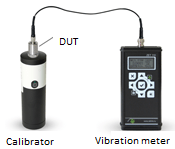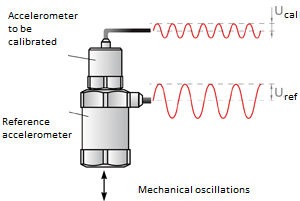In researches of mechanical systems, vibration measuring transducer is the most popular tool. By type of sensing element, the vibration transducers are classified into piezoceramic, capacitive, inductive, and resistive. In measuring and test systems piezoceramic accelerometers are most widely used because they have larger dynamic range and more even AFR if compared to other types of sensors.
The complex tests require connecting several dozens of sensors. Each sensor is periodically checked, and typically the same parameters are defined: conversion ratio, AFR flatness, AR non-linearity, relative transverse conversion coefficient, natural mechanical resonance frequency, etc. Repeatability of these parameters depends on methods and ways of conducting tests.
Choosing a Test Method
The methods of defining vibration transducers parameters can be conditionally divided into three categories:
- Absolute methods, including a method based on application of laser displacement sensor and so on;
- Methods based on application of calibrators, e.g. vibration boards, or vibrators with precisely defined parameters (in particular, vibrotable with mechanical fluctuations parameters, etc.);
- Comparison methods, including comparison with application of mechanically connected accelerometers.

The absolute method of accelerometer calibration based on application of laser motion sensor requires complicated professional equipment and is rarely used in practice.
The absolute methods also include a method based on earth gravity force. When using this absolute method, the accelerometer to be calibrated is carefully turned in a vertical plane so that only earth gravity affects it. This method is only applicable in the low frequency area and used just for calibrating static accelerometers, such as VS 201 and VS 202.
Methods with application of calibrators allow to determine sensitivity of accelerometers and require less equipment. To conduct measurements, besides a calibrator itself, only a recording device, e.g. vibrometer, is required. But since calibrators have rigid frequency and vibration amplitude, they are not suitable for determining some parameters of vibration sensor such as AFR flatness and AR nonlinearity.
Unlike absolute methods and methods based on calibrators, the method of comparison with a sample is applicable for all types of accelerometers, enabling to determine all basic electrical parameters of sensors.
A method of determining parameters of vibration transducers by comparison with a reference sensor is based on relative measurements.
The calibrated vibration transducer is mechanically connected to a vibration transducer used as a reference sensor. This test set is mounted on the vibration table of vibration bench. The vibration bench simulates sinusoidal fluctuations, and the connected accelerometers fluctuate in one and the same plane and are exposed to the same acceleration. The signal voltage of each accelerometer is proportional to acceleration affecting the sensors:

Thus, ratio of electric signal amplitudes from sensors is equal to ratio of their conversion coefficients (see Fig.). [2]

Relative Measurements Principle
Consequently, using the known value of the reference accelerometer conversion ratio we can define the conversion ratio of the calibrated accelerometer:
![]()
To ensure precision and convergence of results obtained during the tests by comparison with a reference sensor, it is necessary to follow MI 1873 guidelines.
